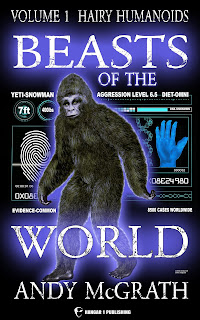 |
| Toying with Nessie! Snapped during the biggest hunt for Nessie in 50 years in 2023! |
However, when I began researching this phenomenon, I was shocked to discover that there were also numerous reports from Britain dating back 100s of years and that they even had Modern-day reports of Bigfoot-like creatures across the country.
Many of these accounts described a tall, bipedal, muscular and hair-covered, wild man, with a domed head and a face something resembling something like that of a ‘caveman’, or chimpanzee, with a flat muzzle and a human-like nose.
Of course, my first instinct was to seek out witnesses and see if there was any historical evidence to back up these modern-day sightings and what I found was a creature called the Woodwoose, a mythical creature whose popularity seems to have become prominent in Europe from the 12th century onwards, where they are depicted as wild, hair-covered men, upon the architectural adornments of cathedrals, tapestries and in heraldic coats of arms of prominent European families.
So far, so good… it’s not often that one finds such corroboration in history, especially one so closely related to other mythical entities in Europe, such as the Satyr, Faun, Ogre, and Leshy, which are similarly described as shy, forest-dwelling, hair-covered beings who are not beyond carrying off the occasional maiden, from time to time! Could this be the key to the unravelling of the wildman mystery, I thought?
 |
| Were scenes such as these commonplace during medieval times? |
Sadly, no! After 6 years of searching the length and breadth of the country for this creature, I have found scant evidence that it still exists in our land. Undoubtedly, there are more than a few eyewitness reports, but these are notoriously lacking in attribution, often being 2nd or even 3rd hand reports and too often emanate from sources who have a ‘skin in the game’ or at least something to gain from this legend!
My sad conclusion is that even those 12th-century carvings that feature so prominently upon the holy houses of Europe are themselves a form of inherited folklore, a memorial in cloth and stone to the stories of a bygone era and that although they may have once existed in Europe, they were probably extinct by the time these carvings and tapestries were created.
But that doesn’t mean that Britain does not have any cryptid creatures in its midst. Indeed, my ‘faith’ in one of these ‘cryptids’ in particular was recently revived when I had the privilege of documenting the biggest search for Nessie in 50 years for a new TV series – Weird Britain.
 |
| WEIRD BRITAIN a new television series investigating the mysteries, histories, folklore & fables of teh British Isles! |
Our team, equipped with Thermal drones, ROVs, Hydrophones, Sonar, and Night Vision technology, worked closely with expedition organiser and founder of Loch Ness Exploration – Alan McKenna to document his crowd-sourced observation of the waters of Loch Ness and finally find proof of the elusive beast!
And although definitive evidence was not obtained, there were many triumphs throughout the expedition weekend, such as; hydrophone ‘bloops’ which were obtained aboard the vessel Deepscan while we filmed Alan McKenna and our expert guest – Ken Gerhard listening to the sounds of the loch, interviewing Matty and Aga, two wild swimmers who had come to lend their aquatic expertise to the hunt and filmed a three humped object near Fort Augustus; and speaking with Japanese-born translator, Chie Kelly, who snapped 61 photos of the beast from the shores of Dores Beach in 2018, but did not share the pictures for five years for fear of being ridiculed until being overwhelmed by the spirit of the most extensive search for Nessie in half a century realised that she could no longer keep them secret, causing Veteran Nessie-hunter and Guinness Book of World Records holder - Steve Feltham to declare them: “...the most exciting photographs ever taken of the Loch Ness Monster!”
 |
| Hanging out at Urquhart Castle a Nessie Hotspot! |
We have to remember that the Loch Ness Monster, unlike the British Bigfoot, has 90 years of continuous sightings and even has older sightings dating back to 565 AD, with corroborative reports being made by eyewitnesses from every walk of life and from 100s of countries around the world. Whereas the British Bigfoot is a feature of the High Middle Ages and disappeared from our histories until the advent of yeti mania in the early 20th century and again later when bigfoot mania reappeared on the media scene with the hugely successful – Finding Bigfoot!
Written by Andy McGrath
Based upon excerpts from Beasts of Britain by Andy McGrath
available from all good online retailers:
Photos/Artwork
Toying with Nessie: Photo by Andy McGrath 2023
Wodewose surrounded by dogs: from the Queen Mary Psalter, England, c. 1310–1320, Royal MS 2 B VII, f. 173r
Weird Britain Logo: designed by Matt Everett
Hanging out at Urquhart Bay: Photo by Andy McGrath
















.jpg)


